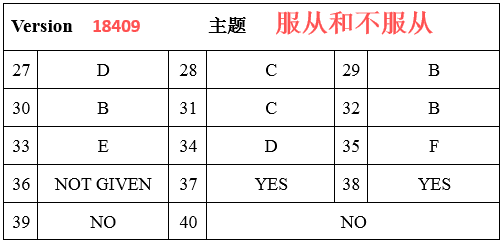很多刚加入GRE备考征途的考生,可能对于GRE阅读的答题要求并不太熟悉就开始了埋头苦练,这种盲目的做法并不可取。 下面小编就和大家分享怎样在GRE阅读备考中锻炼思维方式和能力,来欣赏一下吧。
GRE阅读答题整体思路和细节要求详解
新GRE阅读整体思路和答题要求
先读文章后做题,阅读速度一定要快,勇敢的省略,记住:看题时间要比看文时间长,一般推荐使用两遍法,第一遍通读,重点看文章的结构、focus、作者态度,第二遍在解题时定位阅读。同时,解任何题目时都要回到原文中定位,严格把握文字对应法,每个正确答案都必须找到依据,绝对不可凭记忆或知识背景做题。特别注意的是,不要精读,不必了解文章的意思,速度一定要快,一定要作笔记,时间不够看首段和各段首句。然后,每天都积累几个GRE句子,总之阅读的关键就是:“速度 定位 改写”。
新GRE阅读答题方法
1. 把握GRE阅读题中文章的句子主干
对于语法知识有一定的要求,力求做到一句话只看一遍,充分利用自己的语法知识,时刻把握句子主干,修饰成分要毫无感觉地快速浏览。注意,这里的“毫无感觉”不是略读,而是不希望过多的修饰成分或插入成分影响对句子主干的理解,这四个字还需要自己多练习体会。
2. 在做GRE阅读题时要做好标记
在GRE阅读文章中,除了大写字母、时间年代、最高级、转折标志词、因果标志词、列举、让步、强对比以外,还要标记出并列连接词(比如and)、分号、冒号、表示作者态度的词(褒义贬义词等)。这些内容往往都意味着出题点和解题点,标记好可以有助于理清解题思路。
关于做标记的小窍门介绍:标记符号不要只用一种下划线,也不要标记过多弄得到处都是,个人感觉最多三种,比如分别标记原因、转折和其他即可。常用符号可以是下划线或者括号等。
3. 反复做GRE阅读题
这是提高GRE阅读速度的秘诀:反复阅读已经读过的文章,建议3-5遍左右,慢慢就会养成一种直觉,知道哪里略读哪里重读。
4. GRE阅读题中段首段尾要把握好
每段首句和全文末句一定仔细看。因为这往往是这段内容的主旨和总结,也是比较常见的出题点。
新GRE阅读解题策略
1. 保持好奇心
在GRE阅读平时的练习中,想必大家都会经常读到一些晦涩难懂的概念,这个时候,不同的态度就会对之后的学习产生一些影响。比较积极的思考方式是“真有意思啊,我又了解到某些东西”。虽然事实上你可能一辈子也不会再读到这些文章,去了美国你也只会读关于你专业的学术文章,但GRE为你提供了一个平台,让你去涉猎更多的领域。当你读到美国宪法修正案、美国黑人奴隶斗争史、女性作家时试着让自己置身于这样一个年代,你会发现自己更投入。而在这一过程中,你的知识面也得到了开拓,有时候还会学到一些新的词汇和其他内容,无形之中便提升了自己的英语阅读水平和知识积累。
2. 记录新概念/事件/人物
GRE阅读的pre-knowledge到底有没有用?对于这点,很多老师和学生的看法都不太相同,考虑到GRE阅读有两个难点:句子晦涩难懂和做题时间非常有限,一遍必须读懂,
如果你事先对某一概念了解了,那么pre-knowledge绝对可以帮你化险为夷。但是不要把自己的观点过多的带入到文章,这样会影响你的理解。而当你在阅读的时候读到了自己不熟悉的概念,可以Notebook或者Word等随时记下感兴趣或者不知道想要查阅的东西,或是直接上GOOGLE搜索一下相关概念,对于以后的阅读积累也是很有帮助的。
GRE阅读:提升方法
新旧观点型首先提出过去传统大家都接受的观点,然后出现表示转折或让步的词汇,这些观点是旧观点,最后经过一番论证证伪旧观点,抛出新观点。
现象解释型首先给出一种自然或社会现象,通常很古怪,接着对现象进行解释,解释手段有引用理论、实验验证、举例证明、分层说明以及过程描述等。最后还可能有对解释理论的态度,态度的类型分为支持、反对、无态度(客观公正)以及无明确态度,如果文中解决了问题,可以将之认为作者持正面态度。
结论解释型首先是判断句,然后做出转折。写作方法有:
(a)首句正/负评价,后面的相反评价是结论。
(b)判断句后加情境背景。
(c) 先叙述别人的观点, 最后才是作者的评价(结论)。
问题解决型首先出现设问句,接着给出解决方法。写作方法有:
(a)若有多种解决方案, 注意新老解决方案的区别。
(b)写出解决的原则和手段。
(c)用试验证明解决。
(d)引用原理解决。
掌握了GRE阅读的套路,接下来就是如何提升其阅读速度问题,阅读习惯的培养相当重要,阅读过程中绝对不可以出声朗读,也不可以不出声在脑子里面朗读,因为眼睛拍摄文字把它传向大脑的速度远远大于嘴巴逐字逐句念给大脑的速度,人的大脑可以直接用字形图像来理解含义,而用字音再理解反而会多一道程序。也不能单单对一个词进行死抠,要知道阅读考的是句子和文章。
具体有四个训练项目:一是意群训练,即以几个相邻的词为阅读对象。二是不回视训练,保证第一遍阅读时的高度注意力,避免回视。三是合理化训练,根据文章上下文进行逻辑推理。四是速度与理解力的平衡点训练,首先找出自己的速度与理解力的平衡点,然后在阅读中根据所读内容的难度和重要程度,调整自己的现场阅读速度。
GRE阅读:云和气候
As of the late 1980’s, neither theorists nor large-scale computer climate models could accurately predict whether cloud systems would help or hurt a warming globe. Some studies suggested that a four percent increase in stratocumulus clouds over the ocean could compensate for a doubling in atmospheric carbon dioxide, preventing a potentially disastrous planetwide temperature increase. On the other hand, an increase in cirrus clouds could increase global warming.
That clouds represented the weakest element in climate models was illustrated by a study of fourteen such models. Comparing climate forecasts for a world with double the current amount of carbon dioxide, researchers found that the models agreed quite well if clouds were not included. But when clouds were incorporated, a wide range of forecasts was produced. With such discrepancies plaguing the models, scientists could not easily predict how quickly the world’s climate would change, nor could they tell which regions would face dustier droughts or deadlier monsoons.
15.1. The author of the passage is primarily concerned with
(A) confirming a theory
(B) supporting a statement
(C) presenting new information
(D) predicting future discoveries
(E) reconciling discrepant findings
15.2. It can be inferred that one reason the fourteen models described in the passage failed to agree was that
(A) they failed to incorporate the most up-to-date information about the effect of clouds on climate
(B) they were based on faulty information about factors other than clouds that affect climate
(C) they were based on different assumptions about the overall effects of clouds on climate
(D) their originators disagreed about the kinds of forecasts the models should provide
(E) their originators disagreed about the factors other than clouds that should be included in the models
15.3. It can be inferred that the primary purpose of the models included in the study discussed in the second paragraph of the passage was to
(A) predict future changes in the world’s climate
(B) predict the effects of cloud systems on the world’s climate
(C) find a way to prevent a disastrous planetwide temperature increase
(D) assess the percentage of the Earth’s surface covered by cloud systems
(E) estimate by how much the amount of carbon dioxide in the Earth’s atmosphere will increase
15.4. The information in the passage suggests that scientists would have to answer which of the following questions in order to predict the effect of clouds on the warming of the globe?
(A) What kinds of cloud systems will form over the Earth?
(B) How can cloud systems be encouraged to form over the ocean?
(C) What are the causes of the projected planetwide temperature increase?
(D) What proportion of cloud systems are currently composed of cirrus of clouds?
(E) What proportion of the clouds in the atmosphere form over land masses?
GRE阅读相关文章:
★ GRE词汇如果高效的背诵记忆
★ GRE背单词记不住怎么办
★ GRE词汇考试常见词根词缀汇总
★ 心理学与生活读书心得1000字5篇
★ 夏令营特色活动策划方案
★ 说明文的范文800字,说明文的范文800字
★ GRE词汇易混淆内容整理
★ GRE词汇背诵谐音法
★ 2020GRE分类词汇最新整合
★ 如何能够更有效的背单词呢








 扫一扫支付
扫一扫支付


